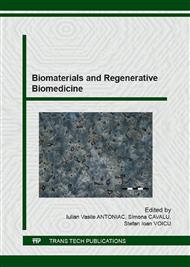[1]
A.L. Andrady, Applications of Nanofiber Mats, Science and Technology of Polymer Nanofibers, John Wiley & Sons, Inc. 2007, pp.225-247.
Google Scholar
[2]
K.H. Kim, L. Jeong, H.N. Park, S.Y. Shin, W.H. Park, S.C. Lee, T.I. Kim, Y.J. Park, Y.J. Seol, Y.M. Lee, Y. Ku, I.C. Rhyu, S.B. Han, C.P. Chung, Biological efficacy of silk fibroin nanofiber membranes for guided bone regeneration, Journal of biotechnology, 120 (2005).
DOI: 10.1016/j.jbiotec.2005.06.033
Google Scholar
[3]
X. Liu, P.X. Ma, Phase separation, pore structure, and properties of nanofibrous gelatin scaffolds, Biomaterials, 30 (2009) 4094-4103.
DOI: 10.1016/j.biomaterials.2009.04.024
Google Scholar
[4]
R. Jayakumar, M. Prabaharan, P.T. Sudheesh Kumar, S.V. Nair, H. Tamura, Biomaterials based on chitin and chitosan in wound dressing applications, Biotechnology advances, 29 (2011) 322-337.
DOI: 10.1016/j.biotechadv.2011.01.005
Google Scholar
[5]
K. Yoon, H.N. Lee, C.S. Ki, D. Fang, B.S. Hsiao, B. Chu, I.C. Um, Effects of degumming conditions on electro-spinning rate of regenerated silk, International journal of biological macromolecules, 61 (2013) 50-57.
DOI: 10.1016/j.ijbiomac.2013.06.039
Google Scholar
[6]
J.S. Ko, K. Yoon, C.S. Ki, H.J. Kim, D.G. Bae, K.H. Lee, Y.H. Park, I.C. Um, Effect of degumming condition on the solution properties and electrospinnablity of regenerated silk solution, International journal of biological macromolecules, 55 (2013).
DOI: 10.1016/j.ijbiomac.2012.12.041
Google Scholar
[7]
Z. -M. Huang, Y.Z. Zhang, S. Ramakrishna, C.T. Lim, Electrospinning and mechanical characterization of gelatin nanofibers, Polymer, 45 (2004) 5361-5368.
DOI: 10.1016/j.polymer.2004.04.005
Google Scholar
[8]
C.S. Ki, D.H. Baek, K.D. Gang, K.H. Lee, I.C. Um, Y.H. Park, Characterization of gelatin nanofiber prepared from gelatin–formic acid solution, Polymer, 46 (2005) 5094-5102.
DOI: 10.1016/j.polymer.2005.04.040
Google Scholar
[9]
M. -H. Ho, C. -C. Hsieh, S. -W. Hsiao, D. Van Hong Thien, Fabrication of asymmetric chitosan GTR membranes for the treatment of periodontal disease, Carbohydrate Polymers, 79 (2010) 955-963.
DOI: 10.1016/j.carbpol.2009.10.031
Google Scholar
[10]
F. Croisier, C. Jérôme, Chitosan-based biomaterials for tissue engineering, European Polymer Journal, 49 (2013) 780-792.
DOI: 10.1016/j.eurpolymj.2012.12.009
Google Scholar
[11]
H. Nagahama, H. Maeda, T. Kashiki, R. Jayakumar, T. Furuike, H. Tamura, Preparation and characterization of novel chitosan/gelatin membranes using chitosan hydrogel, Carbohydrate Polymers, 76 (2009) 255-260.
DOI: 10.1016/j.carbpol.2008.10.015
Google Scholar
[12]
C. Huang, R. Chen, Q. Ke, Y. Morsi, K. Zhang, X. Mo, Electrospun collagen–chitosan–TPU nanofibrous scaffolds for tissue engineered tubular grafts, Colloids and Surfaces B: Biointerfaces, 82 (2011) 307-315.
DOI: 10.1016/j.colsurfb.2010.09.002
Google Scholar
[13]
C. Meechaisue, P. Wutticharoenmongkol, R. Waraput, T. Huangjing, N. Ketbumrung, P. Pavasant, P. Supaphol, Preparation of electrospun silk fibroin fiber mats as bone scaffolds: a preliminary study, Biomedical materials (Bristol, England), 2 (2007).
DOI: 10.1088/1748-6041/2/3/003
Google Scholar
[14]
S. Wang, G. Zhao, Quantitative characterization of the electrospun gelatin–chitosan nanofibers by coupling scanning electron microscopy and atomic force microscopy, Materials Letters, 79 (2012) 14-17.
DOI: 10.1016/j.matlet.2012.03.044
Google Scholar
[15]
M.Z. Elsabee, H.F. Naguib, R.E. Morsi, Chitosan based nanofibers, review, Materials Science and Engineering: C, 32 (2012) 1711-1726.
DOI: 10.1016/j.msec.2012.05.009
Google Scholar
[16]
K. Ohkawa, D. Cha, H. Kim, A. Nishida, H. Yamamoto, Electrospinning of Chitosan, Macromolecular Rapid Communications, 25 (2004) 1600-1605.
DOI: 10.1002/marc.200400253
Google Scholar
[17]
Y. Zhou, H. Yang, X. Liu, J. Mao, S. Gu, W. Xu, Electrospinning of carboxyethyl chitosan/poly(vinyl alcohol)/silk fibroin nanoparticles for wound dressings, International journal of biological macromolecules, 53 (2013) 88-92.
DOI: 10.1016/j.ijbiomac.2012.11.013
Google Scholar
[18]
A. Bigi, G. Cojazzi, S. Panzavolta, K. Rubini, N. Roveri, Mechanical and thermal properties of gelatin films at different degrees of glutaraldehyde crosslinking, Biomaterials, 22 (2001) 763-768.
DOI: 10.1016/s0142-9612(00)00236-2
Google Scholar
[19]
Q. Yu, Y. Song, X. Shi, C. Xu, Y. Bin, Preparation and properties of chitosan derivative/poly(vinyl alcohol) blend film crosslinked with glutaraldehyde, Carbohydrate Polymers, 84 (2011) 465-470.
DOI: 10.1016/j.carbpol.2010.12.006
Google Scholar
[20]
V. Sencadas, D.M. Correia, C. Ribeiro, S. Moreira, G. Botelho, J.L. Gómez Ribelles, S. Lanceros-Mendez, Physical-chemical properties of cross-linked chitosan electrospun fiber mats, Polymer Testing, 31 (2012) 1062-1069.
DOI: 10.1016/j.polymertesting.2012.07.010
Google Scholar
[21]
I. Kołodziejska, B. Piotrowska, The water vapour permeability, mechanical properties and solubility of fish gelatin–chitosan films modified with transglutaminase or 1-ethyl-3-(3-dimethylaminopropyl) carbodiimide (EDC) and plasticized with glycerol, Food Chemistry, 103 (2007).
DOI: 10.1016/j.foodchem.2006.07.049
Google Scholar
[22]
P. Siridamrong, S. Swasdison, N. Thamrongananskul, Preparation and Characterization of Polymer Blends from Nang noi srisaket 1 Silk Fibroin, Gelatin and Chitosan Nanofiber Mats Using Formic Acid Solution, Key Engineering Materials, 659 (2015).
DOI: 10.4028/www.scientific.net/kem.659.28
Google Scholar
[23]
Z. -x. Cai, X. -m. Mo, K. -h. Zhang, L. -p. Fan, A. -l. Yin, C. -l. He, H. -s. Wang, Fabrication of Chitosan/Silk Fibroin Composite Nanofibers for Wound-dressing Applications, International Journal of Molecular Sciences, 11 (2010) 3529.
DOI: 10.3390/ijms11093529
Google Scholar


